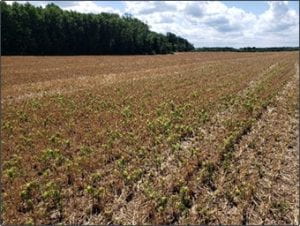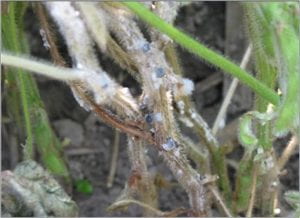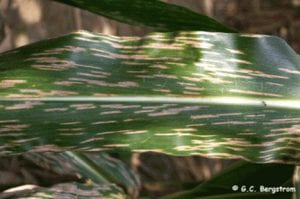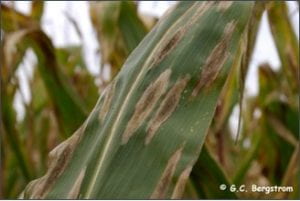
Considerations for Marestail Control in Wheat Stubble

Photo: M. Stanyard / CCE NWNY Team
Riding around the region this week I am seeing a lot of marestail coming up through the wheat stubble. It had been suppressed under the wheat but now the sunlight has woke it up. What are you going to do to manage it before it sets seeds? Mowing, tillage, and herbicides alone and in combination are options. Mark Loux of Ohio State has a great article on how to best utilize each of these options (https://agcrops.osu.edu/newsletter/corn-newsletter/controlling-marestail-wheat-stubble).
The next consideration is whether the field will be fallow or is a cover crop being planted?
Goal: control marestail and other weeds with a burndown, no cover crops. The majority of our marestail is glyphosate resistant so that is not an option by itself. Other options include 2,4-D, dIcamba, Gramoxone, Liberty and Sharpen. Research from Michigan State suggests that “the most effective treatments to control glyphosate-resistant horseweed were Liberty (glufosinate) at 32 fluid ounces per acre (fl oz/A) plus AMS, or Sharpen at 1 fl oz/A or 2 fl oz/A plus Roundup PowerMax at 32 fl oz/A plus MSO plus AMS”. See all the results of the marestail trial here (https://www.canr.msu.edu/news/horseweed-marestail-control-options-in-fallow-prevent-plant-fields). Reminder: Marestail should be sprayed under 6 inches tall for effective control. As these weeds get larger, percent control is reduced.
Goal: control marestail and other weeds, then plant a cover crop. Many growers utilize a cover crop following wheat and other small grains. The major problem with utilizing herbicides prior to cover crop establishment is that 2,4-D, dicamba and Sharpen all have some residual activity and that means delayed planting of cover crops particularly broadleaves (clover, radish, turnip) for 30 days or more. Planting annual ryegrass, oats or cereal rye would be a safer bet with these products. We like to get our cover crops planted during the first two weeks of August. That’s in the next two weeks! Products such as Gramoxone and Glufosinate have no soil activity and so no waiting period to plant any cover crop and could be options for immediately planting broadleaves. Glufosinate would be the best choice. Mark Loux has a Part 2 article that further explains the pros and cons of each of these burndown options (https://agcrops.osu.edu/newsletter/corn-newsletter/marestail-control-wheat-stubble-part-2-cover-crop-considerations).
Be on the Lookout for White Mold in Soybeans

Photo: M. Stanyard / CCE NWNY Team
As soybeans began to flower this year, it was very dry, so the last disease we were worried about was white mold. However, the sporadic rainfall and consistent humidity these past few weeks have me concerned that conditions are setting up to favor this disease. The goal of any white mold suppression program is to first reduce conditions favorable for white mold (select highest tolerant varieties, reduce plant populations and wider rows). Fungicides are another tool but they have to be sprayed in a timely manner as to protect the flower. Fungicides such as Aproach, Endura, Omega and Propulse are all labeled for good to very good white mold control but they have to be able to penetrate the canopy to be effective. Fungicides will not help plants that are already infected.
The white mold spores from tiny mushrooms enter through the decaying flowers and become systemic, eventually killing the plant. Infection begins with a water soaked lesion originating at a node. The sclerotia (reproductive structures) form inside and outside the stem within the cottony white mold mass. Sclerotia are dark, irregularly shaped bodies ¼ to ¾ inches long containing hardened mycelia and are the “seeds” for future infections. Here is a team video on the specifics of white mold biology and management, https://vimeo.com/138306731.
Beginning to See Foliar Diseases in Corn
The dry weather also held off any early infections of common corn foliar diseases such as Northern Corn Leaf Blight (NCLB). I am just starting to get reports of the first small NCLB and Gray Leaf Spot (GLS) lesions identified across the region and some fungicides are being applied.
It is very easy to tell these diseases apart once they get established. NCLB has the large cigar shaped lesions while GLS legions look like wooden matchsticks (see photos). Many fields have begun to tassel (VT) and it is a crucial time for scouting corn and determining if a fungicide application is warranted. Hopefully, you have planned ahead and planted hybrids with the highest level of resistance. Even though spores can move long distances, continuous cornfields and no-till fields with lots of corn residue are also the most vulnerable from local spore development and dispersal. Go to Cornell’s Field Crop webpage to learn more about both of these diseases, http://fieldcrops.cals.cornell.edu/corn/diseases-corn.

Photo: G. C. Bergstrom / Cornell University

Photo: G. C. Bergstrom / Cornell University

